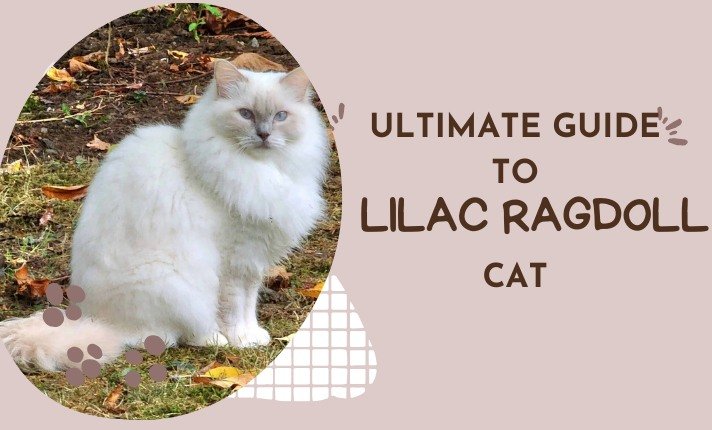Ragdoll cats are a beloved breed known for their stunning appearance, affectionate nature, and laid-back temperaments, making them an excellent fit for families and individuals alike. These originated in the 1960s. Ragdolls are large and muscular cats and often described as “dog-like”. Despite their size, Ragdolls are known for being gentle giants, often seeking out human interaction and enjoying being held and cuddled.
The Ragdoll breed is officially recognized by the Cat Fanciers’ Association (CFA) and the International Cat Association (TICA) in six different colors: seal, blue, chocolate, lilac, flame, and cream. Lilac is identified as one of the official Ragdoll colors, although it’s very rare compared to Seal or Bluepoint Ragdoll.
Lilac Ragdoll Breed overview :
| Breed | Overview |
| Coat color | Soft, pastel lavender gray |
| Points color | Light cool toned gray with pinkish hues |
| Eyes color | Blue, expressive, and large |
| Life Span | 12-15 years |
| Cost | $800 to $5,000 depending on age |
| Behavior | Patient with children, gets along with other pets |
Genetics of Lilac Ragdoll cats
The lilac color in Ragdolls is a result of a specific genetic combination that affects the melanin production and distribution. The interaction between eumelanin and pheomelanin creates the lilac color, which is caused by a combination of dilution genes. Specifically, the recessive alleles of the color points and dilution genes contribute to the pale, pinkish-gray color characteristic of lilac ragdolls.
Understanding the genetics of lilac ragdolls is essential for breeders who want to predict color outcomes and plan breeding programs. Genetic testing can help identify the genotype of individual cats and inform breeding decisions. By grasping the genetics, breeders can make informed decisions and produce healthy, beautiful cats.
Lilac Ragdolls come in different colors, like Lilac Point, Lilac Lynx Point, Lilac-Cream Point, and Lilac-Cream Lynx Point.
Behavioral Traits and Social Personality of Lilac Ragdolls :
Lilac Ragdolls share the same wonderful behavioral traits and social personality characteristics as other Ragdolls. Here are some key characteristics.
1. Affectionate: Lilac ragdolls are extremely affectionate and love human interaction. They often seek out attention and enjoy being held, cuddled, and petted.
2. Laid Back: Lilac ragdoll is known for their calm and relaxed nature. They are not as demanding as some other breeds and are happy to simply lounge around the house.
3. Gentle: Lilac Ragdolls are gentle giants, with a soft and silky coat to match their gentle nature. They are often described as “ lap Cats” because they love to curl up in their owners’ laps and snooze.
4. Intelligent: Lilac ragdolls are highly intelligent and can learn tricks and commands with patience and positive reinforcement.
5. Playful and social: Lilac Ragdolls are not overly demanding they enjoy playing with toys and engaging in interactive games. They are highly social and make great families with pets, and are often described as “ Velcro Cats.”
6. Loyal and Devoted: Lilac Ragdolls are loyal and devoted to their owners and form a strong bond with their family members.
History & Origin of Lilac Ragdoll Cats:
The Ragdoll breed originated in the 1960s with breeder Ann Baker in California. Lilac was not among the original colors but developed later through selective breeding. The unique diluted chocolate coloring became officially recognized as the breed evolved and gained popularity worldwide.
How Rare Are Lilac Ragdolls?
Lilac Ragdolls are considered one of the rarest Ragdoll color types. The combination of recessive genes makes them difficult to breed. Because of this, Lilac Ragdolls are highly sought-after and usually cost more than their more common counterparts, like Seal or Blue Ragdolls.
Lilac Ragdoll Kittens: What to Expect
Lilac Ragdoll kittens are born white and develop color over 8–12 weeks. They are playful, loving, and easy to socialize with. Expect clinginess, floppy cuddles, and lots of curiosity. Kittens should stay with their mother for at least 12 weeks before adoption to ensure proper development.
Lilac Ragdoll vs Other Ragdoll Colors:
| Feature | Lilac Ragdoll | Blue Ragdoll | Seal Ragdoll |
|---|---|---|---|
| Rarity | Very Rare | Common | Common |
| Color | Pale grey/pink | Cool bluish-grey | Deep brown |
| Cost | High | Moderate | Moderate |
| Popularity | Growing | Popular | Most Popular |
Different Types of Lilac Ragdoll Cats
- Lilac Point Ragdoll
- Lilac Cream Point Ragdoll
- Lilac Bicolor Ragdoll
- Lilac Mitted Ragdoll
- Lilac Tortie Ragdoll
- Lilac Lynx (Tabby) Ragdoll
1. Lilac Point Ragdoll
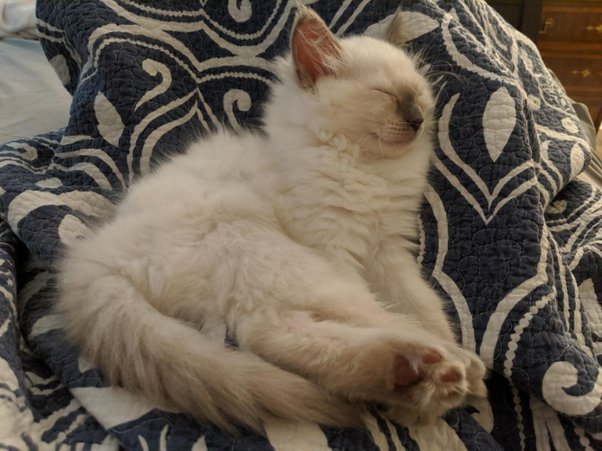
Lilac point Ragdoll cats have a light body with distinct lilac- colored points on their ears, face, paws, and tail. The points are an icy grey with hints of lavender, creating a gentle contrast with their pale, creamy white body.
This type of Ragdoll does not have any extra white markings, and the pointed areas give them a classic Ragdoll appearance, characterized by darker coloration on the extremities and a lighter torso.
The rarity of the lilac coloration adds to their allure, as they are less common compared to other colors like blue or seal.
2. Lilac Mitted Ragdoll
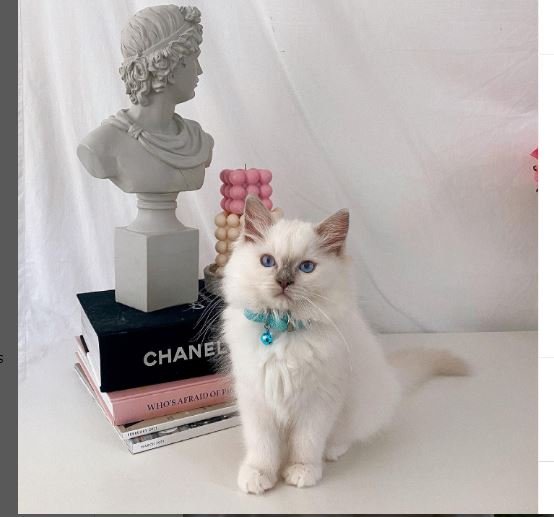
Lilac Mitted Ragdoll features lilac points similar to the colorpoint, but with distinctive white markings. They have “ mittens” on their hind legs with a white stripe running from their chin to their belly.
The hind legs also have white boots that extend upward, and they typically have a white stripe running from their chin down to their belly.
Lilac-mitted ragdoll Cat is also very Rare.
3. Lilac Bicolor Ragdoll
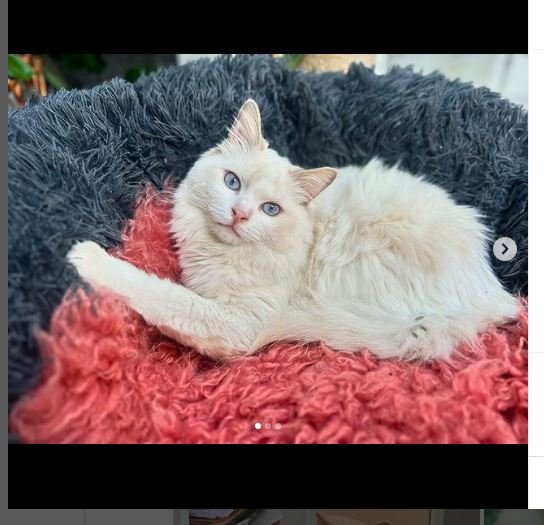
Next up, let’s explore the stunning, but very rare, lilac bicolor ragdoll.
Lilac Bicolor ragdolls have a unique mix of lilac and white fur, with an inverted “V” of white fur on their forehead and extending down over their nose, whisker pads, and chest. Their body are mostly white with lilac points. In addition to the white facial markings, their body are mostly white, with lilac points primarily on the ears and tail.
Unlike the Mitted or Colorpoint varieties, the Bicolor Ragdoll has larger areas of white, making them appear even lighter overall.
4. Lilac Lynx (Tabby) Ragdoll
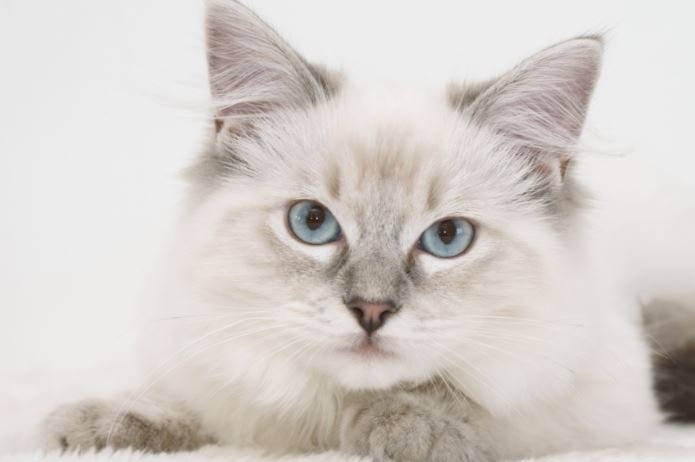
Next up, let’s explore another type of lilac ragdoll cat, but rare, the lilac Lynx ragdoll.
Lilac Lynx Ragdolls are known as lilac tabby ragdolls. These cats feature a beautiful tabby-like stripe pattern on their points. The Lynx markings appear on their ears, face, legs, and tail with a cool grey color and undertones of lilac. The lynx pattern is superimposed on the traditional lilac points.
The Lynx pattern can be combined with any of the other Ragdoll varieties—Colorpoint, Mitted, or Bicolor—resulting in a variety of beautiful and unique combinations. The Lilac Lynx Mitted Ragdoll, for example, will have both tabby striping and white spots.
5. Lilac Tortie Ragdoll

The Lilac Tortie Ragdoll, or Lilac Tortoiseshell, combines the beautiful lilac base color with patches of cream or red, creating a mottled, almost marbled appearance. The tortie pattern is rare and primarily found in female cats.
The Lilac Tortie can also feature lynx markings, resulting in a Lilac Tortie Lynx Ragdoll.
6. Lilac Cream Point Ragdoll
Lilac Cream Point Ragdolls have a body that is glacial white with points that are a combination of lilac and cream. The cream mottling adds a warm hue to the otherwise cool lilac points.
The ears, face, paws, and tail are adorned with these mixed points, making the Lilac Cream Point stand out from other Lilac Ragdolls due to the added warmth in color.
Grooming Requirements :
Lilac ragdolls have a beautiful semi-longhaired coat that requires regular grooming to prevent matting and tangling. Here are some tips to follow.
1. Brush Regularly: Use a wide-tooth comb or a slicker brush to avoid tangles and mats from your lilac. Brushing helps to distribute natural oils in the skin and prevents dryness and itchiness.
2. Focus on trouble areas: pay extra attention to areas prone to matting, such as the armpit, behind the ears, and around the base of the tail.
3. Bath occasionally: Lilac cats do not need frequent baths, but occasional bathing can help keep their coat clean and healthy. Use a gentle pH-balanced shampoo to restore the natural oils of their skin.
4. Dental care: brush your lilac ragdoll’s teeth regularly to prevent tartar buildup and promote good oral health.
5. Ear Cleaning: Clean your lilac ragdolls’ ears weekly to prevent wax buildup and infections.
Nutritional Diet
Lilac Ragdolls, like all cats, are obligate carnivores and require a diet rich in protein from animal sources. Look for food with named protein sources like chicken, salmon, or beef. Avoid genetic terms like “meat” or by byproduct”. Ensure the food contains vital nutrients like Vitamin A, Vitamin D, Calcium, and phosphorus. Ragdolls can be prone to obesity, so monitor fat intake and make sure it is balanced.
You can use commercial foods from brands like Orijen, Acana, or Blue Buffalo. Consult with a veterinarian to ensure a balanced and safe diet. Keep an eye on your cat’s weight, coat condition, and overall health.
Health Screening and Preventive Measures
Lilac Ragdolls, like all cats, require regular health screening and preventive care to ensure they live a long and healthy life. Here are some key considerations:
Health Screening
Hypertrophic Cardiomyopathy: Ragdolls are prone to HCM, a heart condition that can lead to heart failure. Regular echocardiograms can help detect HCM.
Polycystic Kidney Disease: Ragdolls can be prone to PKD, a genetic disorder that cause cysts to form on the kidneys. Ultrasound screening can help detect PKD.
Hip Dysplasia: Ragdolls can be prone to hip dysplasia, a genetic condition that affects the hip joint. X-rays can help detect hip dysplasia.
Preventive Care :
Vaccination: Keep your Lilac Ragdolls up to date on all recommended vaccinations, including rabies, distemper, and upper respiratory infections.
Parasite Control: Regularly check for and prevent parasites like fleas, ticks, and worms.
Dental Care: Regular dental care can help prevent tartar buildup, gum disease, and tooth loss.
Nutrition and weight management: feed a balanced diet and monitor your cat’s weight to prevent obesity related health issues.
Regular check-ups: Schedule regular check-ups with your veterinarian to monitor your cat’s health and detect any potential issues early.
DNA Testing: consider genetic testing for inherited conditions like HCM and PKD to identify potential health risks.
Exercise
Engage your lilac Ragdoll in playtime activities like chasing toys, feather wands, or laser pointers.
Use interactive toys like puzzle toys, treat-dispensing toys, or catnip toys to keep your cat active and engaged.
Provide cat trees or climbing structures to encourage physical activity and exploration.
Offer window perches or cat shelves to allow your cat to observe the outdoors and get some exercise.
Basic care checklist of Lilac Ragdoll cats
| Task | Frequency |
| Brush coat | 2-3 times weekly |
| Nail trim | Every 2-4 times per week |
| Clean ear and eyes | Weekly |
| Vet checkup | Annually |
| Dental care | Weekly |
| Vaccination | As scheduled |
| Flea/ticks/worms | Monthly and quarterly |
Myths and misconceptions about Lilac Ragdolls
Ragdolls are always Floppy:
Reality is, ragdolls are known for their relaxed nature. They tend to relax in your arms, but each cat has its unique quirks and temperaments
Ragdolls are Hypoallergenic:
The reality is that no cat breed is truly hypoallergenic. Ragdolls produce allergens like other cats, so if you have an allergy, it is better to spend time with one before adopting.
Ragdolls do not shed:
While their shedding is lighter than some breeds, lilac ragdolls do shed. Regular grooming can help manage loose hair.
Ragdolls are overly clingy:
Ragdolls are affectionate but not overly demanding. They enjoy human interaction, who want the owner’s company but not a clingy companion.
All Ragdolls are alike:
The reality is Ragdolls come in various coat patterns, including colorprint, mitte,d, and bicolor, each with its unique charm.
FAQs
1. What is a lilac ragdoll cat?
Lilac ragdoll is a rare and beautiful color variation of the ragdoll breed characterized by a pale, lavender-gray coat with pink undertones and blue eyes.
2. What does a lilac ragdoll look like?
Lilac ragdoll has a soft, lavender-grey coat with pinkish undertones, light gray to pink points.
3. Do lilac ragdolls require extra grooming?
Yes, lilac ragdolls need regular brushing to prevent matting and tangling.
4. How much do lilac ragdoll cats cost?
The price of a lilac ragdoll kitten can range from &800 to &5,000, depending on factors like age, bloodline, breeder location, and show-quality status.
5. Where can I find a lilac ragdoll kitten?
Look for reputable breeders who specialize in lilac ragdolls or check with breed-specific rescues and cat shows.

Hey guys, My name is Simon Smith. I’m from Canada and live near Victoria
I live with my sweet family and have 20+ Ragdolls of different types. I love them as my children. My profession is as a hotel manager.
I love to keep Ragdolls and grow their breeder case. I have 7 years of experience.
I’m an expert in cat care. So, I’m here to provide you with new information about my cats daily. This is my blog website, so I request that you kindly visit our site daily.
If you’re a Ragdolls lover and you have any questions or confusion about cats, text me on the Contact Us page or Gmail.
Thank u
